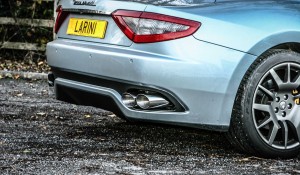What are the Benefits of Stainless Steel?
Corrosion Resistance - The corrosion resistance of stainless steel arises from a "passive", chromium-rich, oxide film that forms naturally on the surface of the steel. The key to the durability of the corrosion resistance of stainless steel is that if the film is damaged it will normally self-repair. Whereas other types of steel suffer from general corrosion, where large areas of the surface are affected, stainless steel in the "passive state" is normally resistant to this form of attack.
This high resistance to corrosion means that constructing an exhaust from stainless steel will result in an immeasurably longer life span compared to normal mild steel. Structures made from stainless steel will often last many times the normal expected life of a mild steel structure (well over 100 years in most cases).
Strength - The mechanical properties of stainless steel allow comparatively thinner sections to be used than with other materials, thus reducing weight without compromising strength. Austenitic grades allow for reduced thickness over traditional grades, while strength is actually increased compared to identical amounts of mild steel.
Aesthetic Appearance - The bright easily maintained surface of stainless steel provides an attractive and contemporary appearance, ideal for a wide and growing range of applications and manufactured products.
Low long-term costs - The unique surface of stainless steel has no pores or cracks to harbour dirt, grime or rust. Stainless steel may be more expensive initially, but the extra value is offset by the durability and longevity of the steel, and significant cost savings are achieved in the long run. Therefore, when the total life cycle costs are considered, stainless steel is often the least expensive option.

Temperature resistance - Special high-chromium and nickel-alloyed grades resist scaling, corrosion and oxidation, and retain strength at high temperatures. Stainless steel is used extensively in heat exchangers, super-heaters, boilers, feed water heaters, valves and main steam lines as well as aircraft and aerospace applications because of its excellent resistance to high temperatures. Additionally, the austenitic microstructure of the 300 series allows the steel to easily withstand and perform in temperatures well below freezing.
Ease of Fabrication - Modern steel manipulation techniques mean that stainless steels can be cut, welded, formed and fabricated as readily as traditional steels and other materials.
Can stainless steel rust?
Stainless steel does not “rust” as you think of regular steel rusting - with a red oxide on the surface that flakes off. If you see red rust, or ‘scaling’, it is likely due to some iron particles that have contaminated the surface of the stainless steel and it is in fact these iron particles that are rusting. If the iron is embedded in the surface it is easily removed by gently applying pressure via a mildly abrasive material. Afterwards, stainless steel generally displays its original finish. Stainless steels typically require little or no maintenance.
 More Than a Name
More Than a Name The Method
The Method Heritage
Heritage Press
Press The Difference
The Difference Product Availability
Product Availability Competition GT
Competition GT Touring GT
Touring GT Super Series GT
Super Series GT Dealer Network
Dealer Network Warranty
Warranty Vehicle Manufacturer Warranty
Vehicle Manufacturer Warranty Computer Enhancement
Computer Enhancement Induction Technology
Induction Technology Lightweight Mufflers
Lightweight Mufflers Valve Technology
Valve Technology Exotic Tone Mufflers
Exotic Tone Mufflers Manifolds
Manifolds Stainless Steel
Stainless Steel Construction/Finish
Construction/Finish Contacts
Contacts Enquiry Form
Enquiry Form Order Form
Order Form Placing Your Order
Placing Your Order Terms and Conditions
Terms and Conditions Payment Methods
Payment Methods Prices and Taxes
Prices and Taxes Delivery and Customs Costs
Delivery and Customs Costs Searching Our Collection
Searching Our Collection